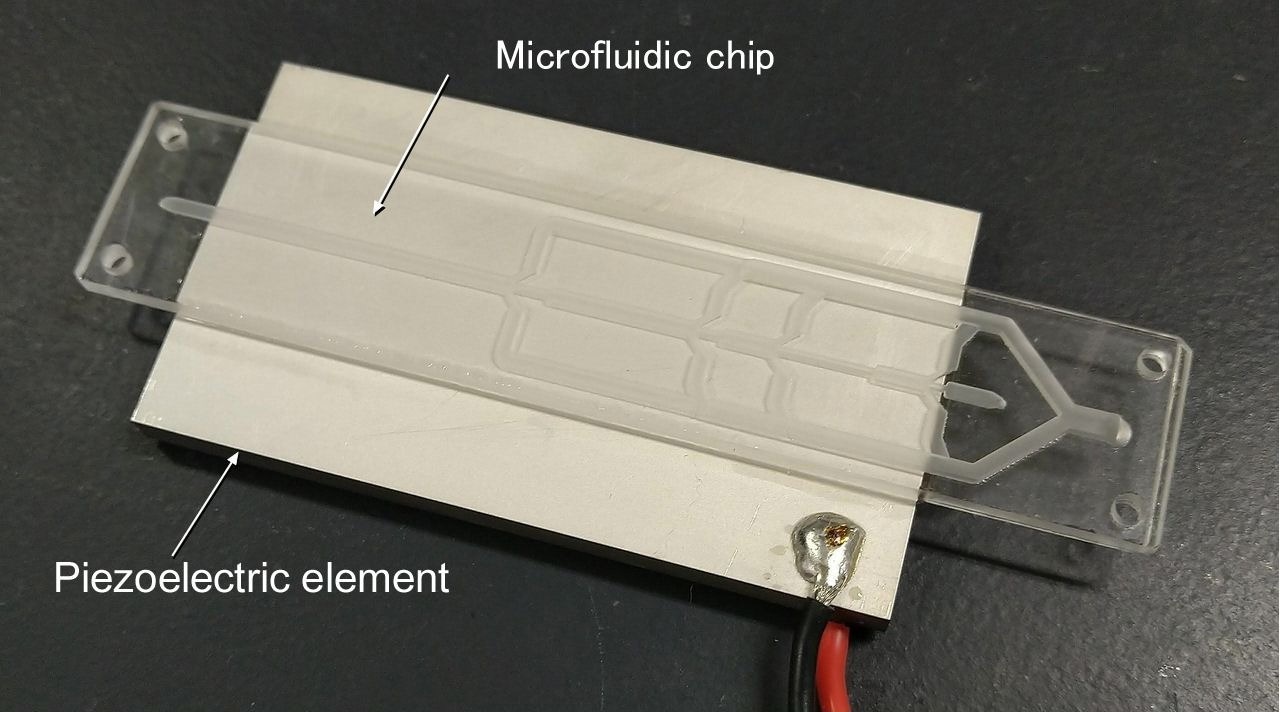Microplastics (MPs), plastic debris smaller than 5 mm, implicitly destroy the environment. Traditionally, they have been collected and removed from water via mesh filtration, which is ineffective.

The device developed by researchers from Japan has four serial trifurcated junctions where a 500 kHz acoustic wave is applied for a 105-fold enrichment of various-sized microplastics in water. Image Credit: Yoshitake Akiyama from Shinshu University.
In this regard, scientists from Japan created a high-enrichment microfluidic system that uses acoustic focusing to collect and remove 10–200 μm MPs from wastewater without recirculation. On test samples, its collection rates and enrichment ratios ranged between 70 and 90% and 50 and 100%, respectively.
Microplastics (MPs), which are plastic debris particles smaller than 5 mm in size, are a severe environmental problem. They adsorb and introduce toxic chemicals into the environment due to the breakdown of plastic waste due to wear and tear and sunlight or as fiber waste in laundry wastewater and microbeads in beauty products. MPs may outnumber the fish in the oceans by 2050. As such, collecting and removing MPs from water is vital.
MPs are traditionally gathered by filtering water through meshes. Density separation and chemical treatment remove sand and biological contaminants from the collected MPs. Following that, the MPs are manually picked up, which can be tedious and significantly time-consuming.
Furthermore, the meshes can become easily blocked and cannot catch particles smaller than their aperture. They also necessitate regular maintenance and are costly. Given these limitations, researchers have created microfluidic devices — systems that manage minuscule volumes of fluids via micrometer-sized channels — that gather MPs via acoustic focusing.
The acoustic technology generates ultrasonic waves that transport MPs to the center of the fluid stream and thereby enrich, i.e., increase the collected amount, of MPs. However, high enrichment of MPs using current microfluidic devices requires repeated recirculation of fluids through them.
In this regard, a team of researchers led by Professor Yoshitake Akiyama of the Department of Mechanical Engineering and Robotics at Shinshu University’s Faculty of Textile Science and Technology has created a high enrichment device for 10–200 μm.
This instrument was reported in research co-authored by Professor Hiroshi Moriwaki of Shinshu University’s Department of Applied Biology, Faculty of Textile Science and Technology, which was made available online on March 26th, 2023, and will be published in Volume 315 of the Separation and Purification Technology Journal on June 15th, 2023.
Our proposed microfluidic device, which is designed based on a hydraulic–electric analogy, has three 1.5 mm-wide microchannels connected via four serial 0.7 mm-wide trifurcated junctions. The MPs are aligned at the center of the middle microchannel using a bulk acoustic wave of 500 kHz resonance frequency. As a result, a 3.2-fold enrichment of MPs must occur at each junction, resulting in a 105-fold overall enrichment in the device.
Yoshitake Akiyama, Professor, Department of Mechanical Engineering and Robotics, Shinshu University
While the MPs are collected from the middle branch of the trifurcated junctions, the remaining MP-free fluid is removed from the other branches.
The researchers assessed the device’s collection capability by evaluating total collection rates for microparticles with diameters of 5, 10, 15, 25, 50, and 200 μm. Except for 5 μm microparticles, which were too tiny to regulate acoustically, collection rates surpassed 90%.
Furthermore, the researchers put the gadget through its paces with two different sample water mixtures: one with tiny MPs (25–200 μm) and another with very small MPs (10–25 μm). Its collection rates ranged from 70–90%, and the actual enrichment of MPs varied from half the design value of 105 to the design value.
Even though some MPs were found to slow down and clog the device’s microchannel walls due to acoustic radiation force, the scientists believe that these small restrictions can be easily solved with pre-filtration and improved 2D focusing.
This proposed microfluidic device based on acoustic focusing can efficiently, rapidly, and continuously collect 10–200 μm MPs without recirculation after pre-filtration of larger MPs through a mesh. It can be installed in washing machines, factories, and other sources of MPs for efficiently enriching and removing various-sized MPs from laundry and industrial wastewater. This will make it possible to prevent the discharge of MPs to the environment.
Yoshitake Akiyama, Professor, Department of Mechanical Engineering and Robotics, Shinshu University
Journal Reference:
Jonai, T., et al. (2023). A collection device for various-sized microparticles that uses four serial acoustic separations: Working toward microplastic emission prevention. Separation and Purification Technology. doi.org/10.1016/j.seppur.2023.123697.